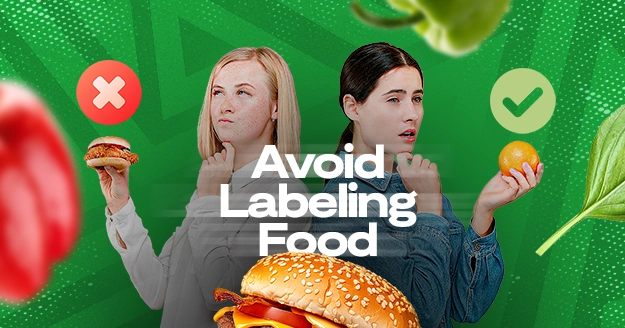Don’t eat this, it’s bad food. Eat this instead because this is good.
Labeling foods as good or bad is incredibly normalized in how we talk about food.
There is no justification for feeling self-righteous about eating some foods while feeling humiliated or guilty about eating others. In addition to providing energy for our bodies, food is also designed to be enjoyable and joyful.
What does categorizing food as good or bad look like? Take a look at this:
Good Carbs vs. Bad Carbs
For example, some experts teach you good carbs vs bad carbs – how to choose carbohydrates wisely to maintain a healthy diet.
Good carbs, like brown rice, whole grains, and legumes, don’t raise blood glucose quickly. Bad carbs, like cookies, white bread, and sugary sodas, cause blood glucose to rise quickly.
You’ve probably heard from other sources that in order to achieve your body goals, you need to avoid carbs. However, it is important to note that eating carbohydrates can be healthy if you eat them in moderate amounts.
Good Fats vs Bad Fats
Polyunsaturated and monounsaturated fats are types of healthy fats. Vegetables, nuts, seeds, and seafood are the main sources of these healthy fats.
In addition to lowering the risk of heart disease, healthy fats also aid with blood sugar and cholesterol regulation, and inflammation reduction. Healthy fats have been demonstrated to help gut health as well as blood pressure control.
Increased levels of “bad” cholesterol (LDL or low-density lipoprotein cholesterol) can result from having a diet high in saturated and trans fats.
Bad fats increase blood pressure and total cholesterol. They can make you more susceptible to some types of cancer, diabetes, and heart disease.
But again, nothing is truly “bad” as long as you eat them in moderation.
Labeling food as good and bad food, a common practice, is not just scientifically and nutritionally inaccurate, but it also detrimentally affects our connection with food. Then…
Why Should We Stop Labeling Food Good and Bad?
-
It’s not black and white.
Do you consider yogurt a “good” or “bad” food?
Yogurt is an excellent source of probiotics, protein, and calcium. So good, right?
But two to three containers of yogurt consumed daily might increase your daily calorie and sugar intake by about 500 calories. This may result in unintended weight gain and raise your chance of developing diabetes. So, is yogurt, then, bad?
Not entirely. Good and bad foods are not only determined by what you eat but how much, how little, and how often. Foods can offer nutrition and enjoyment, but always remember to eat in moderation and consider your current state of health.
-
It promotes shame and guilt.
The designation of some items, such as nachos, pizza, or sweets, as “bad” or “junk food” causes intense feelings of guilt and shame. Additionally, this can result in psychological anguish, anxiety, and despair once you start to shame yourself into thinking that you are a bad person because of your food choices and eating habits.
On the other hand, if you start to believe that you are a good person just because you consume a lot of fruits and vegetables, which are promoted as being “good,” “healthy,” and “better,” this may lead you to judge and stigmatize people who don’t follow your example, which will ultimately help to perpetuate shame.
-
It could cause eating disorders.
When people view food as intrinsically good or bad, moral or immoral, or even healthy or ill, it makes individuals who eat “bad” or forbidden foods feel incredibly ashamed.
In order to make up for the “bad” food, people who feel ashamed about having failed at their diet or eaten the wrong thing may develop eating disorders. Limiting calories, taking laxatives or diet pills, inducing vomiting, and engaging in excessive exercise are a few examples of these disordered eating practices.
Shame can also trigger periods of binge eating, in which a person eats a lot of food in a short amount of time. Additionally, these episodes of binge eating frequently make the shame worse, creating a vicious cycle of shame and disordered eating.
-
Health and nutrition get mixed up.
Health and nutrition are not entirely synonymous.
Nutrition is not nearly as complex as health. It includes social, psychological, and monetary aspects.
If you’re trying to eat only the most nutritious of foods but that results in you being socially isolated, having to spend all of your time and money, and constantly worrying about eating the “right” foods, then that wouldn’t be a very healthy way of eating.









